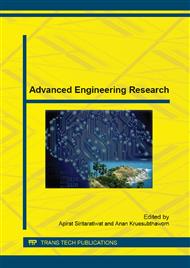p.69
p.73
p.77
p.81
p.85
p.89
p.93
p.98
p.102
Analysis of Ionospheric Irregularity Observed near Suvarnabhumi International Airport in Thailand
Abstract:
The ionospheric irregularity is a major effect to the radio signals since the irregular electrons density can degrade the performance of the Ground-Based Augmentation System (GBAS). This work proposes the methods to calculate three parameters in the ionospheric threat model: front speed, front slope, and front width. The data of PRN9 satellite at three reference stations near Suvarnabhumi international airport, Thailand: KMITL, STFD and DPT stations, on 25th September 2012 are analyzed. The results show that the front speed is about 142.86 meters/second, the maximum front slope is-30 mm/km and the front width is higher than 25 kilometers.
Info:
Periodical:
Pages:
85-88
Citation:
Online since:
August 2015
Keywords:
Price:
Сopyright:
© 2015 Trans Tech Publications Ltd. All Rights Reserved
Share:
Citation:


